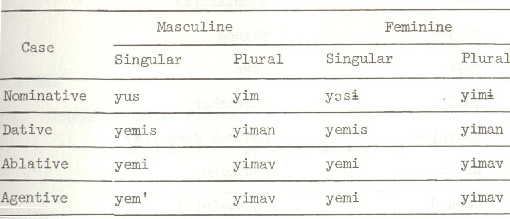|
|


|
|
 |
 |
 |
 |
|

|

Visiting
the Amarnath Cave
|
|
GRAMMAR
|
- Indefinitizer

 is an indefinitizer
which is used with
is an indefinitizer
which is used with  'hundred',
'hundred',  'thousand',
'thousand',  'one hundred thousand', and
'one hundred thousand', and  'one hundred
'one hundred  ', e.g.,
', e.g.,

- The use of

In this lesson we have
introduced  . In conversational Kashmiri it is used in the sense of 'that means, does it
not?' or 'in other words'. Consider, for example,
. In conversational Kashmiri it is used in the sense of 'that means, does it
not?' or 'in other words'. Consider, for example,

The response is

In this context,  translates as 'that means' or 'in other words'.
translates as 'that means' or 'in other words'.
- Pronouns VII: Relative
Pronouns
The relative pronouns followed
by their correlative f.mp3s occur as relative clause markers. The relative
pronoun  has the following f.mp3s:
has the following f.mp3s:

The following table gives the declension of the
relative pronoun  :
:

- Relativization
A relative clause is
introduced by a relative pronoun. It occurs after the nominal head in a
sentence. Consider the following constructions:


There may be several levels of relative clauses in a
sentence, e.g.

'Ashok lives in the white house which is near Dal
Gate which has big glass windows.'.
|
| |
 |
 |
 |
 |
|
|
|
|
|
|